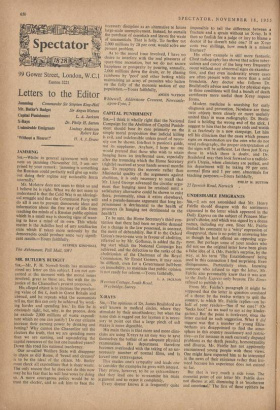X-RAYS SIR,—The opinions of Dr. James Bruilsford are well known
in medical circles, where they stimulate by their unorthodoxy; but when the same dish is ragged out for laymen it is neces- sary to• point out that a large pinch of salt makes it more digestible.
His main thesis is that more and more clini- cians are using X-rays as an easy way to save themselves the bother of an adequate physical examination. His department therefore becomes overloaded with the taking of an un- necessary number of normal films, and is forced into extravagance.
This excites one's sympathy and leads one to consider the examples he gives with interest. They prove, however, to be so extraordinary that they lead one to re-examine his main atgument and to reject it completely.
Every doctor knows it is frequently quite impossible to tell the difference between a fracture and a sprain without an X-ray. Is it then so foolish for a judge or jury to blame a doctor if he doesn't take one? lf an X-ray costs two shillings, how much is a missed fracture?
His other example is still more fantastic. Chest radiography has shown that active tuber- culosis and cancer of the lung very frequently occur without any abnormal signs on examina- tion, and that even 'Moderately severe cases are often present with no more than a mild bronchitis. Any doctor who follows Dr. Brailsford's advice and waits for physical signs in these conditions will find a bunch of death certificates more useful than X-ray request forms.
Modern medicine is searching for early diagnosis and prevention. Nowhere are these twin object more closely or more usefully united than in mass radiography. Dr. Brails- ford is holding the wrong end of the slick. I suggest to him that he changes ends and wields it as fearlessly in a new campaign. Let him tell his clinicians that the cases which present signs on examination are the ones who do not need radiography, the proper interpretation of the signs will be sufficient. Let them just X-ray those in which there is doubt, and Dr. Brailsford may then look forward to a radiolo- gist's Utopia, when clinicians are perfect, and his department will be taking 99 per cent. normal illms and 1 per cent. abnomals for teaching purposes.—Yours faithfully,










































































 Previous page
Previous page